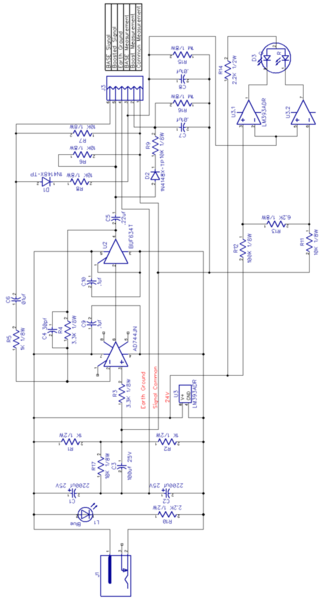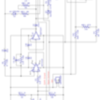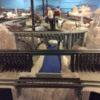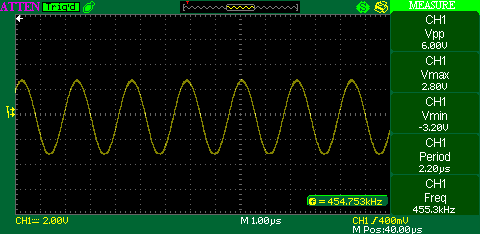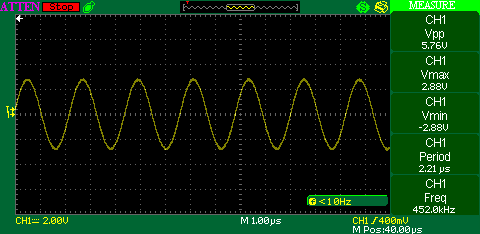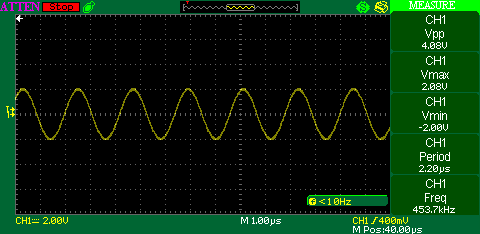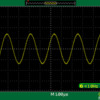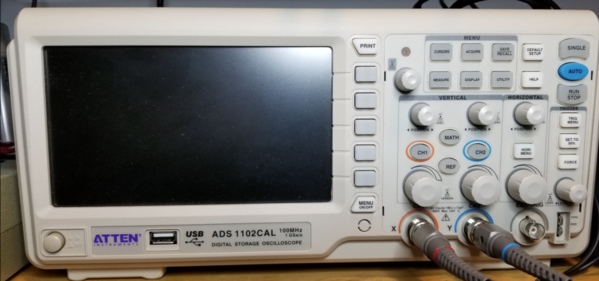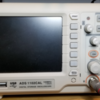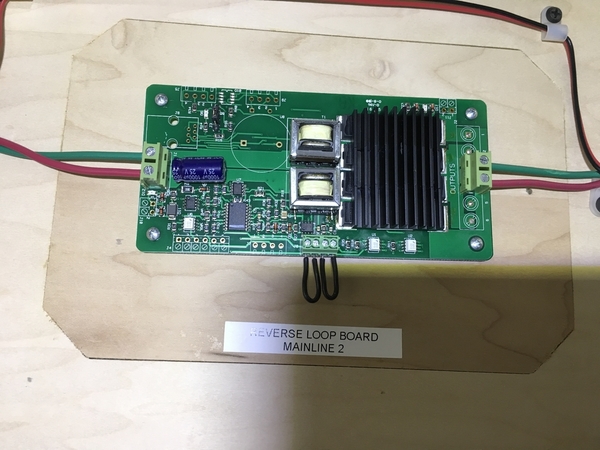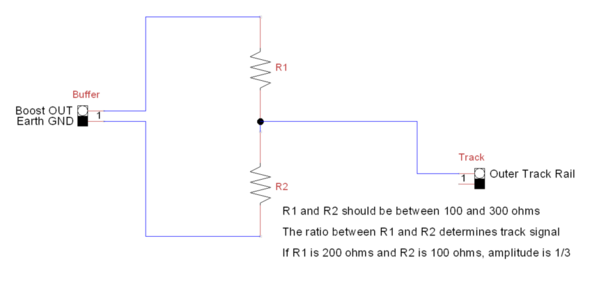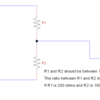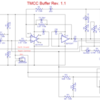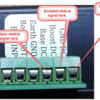That sounds like more fun! I think you will really enjoy the benchwork part anyway, but it goes pretty quick.
Folks,
In case you didn't get an email, the buffers are ready to be shipped. Check your email and SPAM filters, and note that I sent a second message to correct bad math in my first message! ![]()
It's been a long road, but I see the station just ahead, we're through the tunnel with the mystery light up ahead! ![]()
For folks that would like a machine readable copy of the "final" documentation, here's a copy.
Attachments
Nice documentation! You do a real nice job of putting those all together, and color pics too!! (Got email, final pmt coming today, here in a bit)
Hi John. Just sent the balance payment to you.
Pat,
Thanks, however you missed the shipping. ![]()
Insured shipping charges in addition to the $90 remaining balance are as follows:
(1) Buffer, $12 - Total $102
(2) Buffers, $20 - Total $200
(3) Buffers, $20 - Total $290
(4) Buffers, $25 - Total $385
Hi John: Thanks for the buffer, I installed it on my 25'x50' 2 levels layout with 800' of GarGraves track, I run my K-line, 3rd Rail, TMCC, Legacy, Vision Line locomotives and they run flawlessly on both levels, going thru two home made aluminum bridges 4' long, no issues at all; the two LED's are On, one is blue and the other one is solid green all the time; thank you Manco (REP) and you, GOOD IMPROVEMENT, just awesome.
Churu posted:Hi John: Thanks for the buffer, I installed it on my 25'x50' 2 levels layout with 800' of GarGraves track, I run my K-line, 3rd Rail, TMCC, Legacy, Vision Line locomotives and they run flawlessly on both levels, going thru two home made aluminum bridges 4' long, no issues at all; the two LED's are On, one is blue and the other one is solid green all the time; thank you Manco (REP) and you, GOOD IMPROVEMENT, just awesome.
Churu: That's the news we like to hear. Thanks, cannot wait until I get mine. Ain't it GREAT !!!!
Success stories, that's the only kind we want to hear! ![]()
Seriously, that's great to hear, I'm happy they're doing the intended job. I'm busy prepping labels to ship 40 more, hopefully they go out today.
I was thinking to print the schematic and keep it with the the instructions. But I can’t find it, on the forum. Anyone have the link?
Yes folks, they're really being shipped! ![]() These will be going out today.
These will be going out today.

Attachments
Here's the latest schematic. I decided not to print 100 copies of the schematic for the shipments as it's easily obtained, and a vast majority of folks will have no use for it.
Attachments
Excellent, thank you.
Just got a notice that mine is in the mail.
Dropped a bunch of boxes off at the USPS, so a few folks should get some notices. ![]() I'm packing some more this afternoon, those will probably go out tomorrow.
I'm packing some more this afternoon, those will probably go out tomorrow.
MartyE posted:cjack posted:I was thinking to print the schematic and keep it with the the instructions. But I can’t find it, on the forum. Anyone have the link?
Like this? This version still had the schematic. John will have to verify if it is still up to date as I see he posted a newer document.
Thanks Marty, note that the schematic from GRJ is the later one with the caps across the opamp power pins. But much appreciated! I'm saving both with the instructions.
cjack posted:MartyE posted:cjack posted:I was thinking to print the schematic and keep it with the the instructions. But I can’t find it, on the forum. Anyone have the link?
Like this? This version still had the schematic. John will have to verify if it is still up to date as I see he posted a newer document.
Thanks Marty, note that the schematic from GRJ is the later one with the caps across the opamp power pins. But much appreciated! I'm saving both with the instructions.
Cool. Wasn't sure if it was up to date. Glad he posted. I'll delete mine so as to not to confuse anyone.
Hay GRJ,
Will get payment out this weekend to you, for $102.
Steam Forever
John
Just received my buffer today, Great work John.
I hooked it up and found out my Legacy base was bad, only .080 volts base input and 0.100 base output red led. and then hooked up to my cab Legacy and read a 1.140 volts base input and 3.916 volts base output no light on signal level,measured with fluke 87 meter. It look like my legacy is dead.
Thanks John. Received the Booster today. . I'll connect it this week. Great job!
I received an email notice that I will be getting a package from John Will, Thank you John.
Ray
A bunch of them are sitting on the porch for pickup, but they USPS has been somewhat unreliable lately at picking up. If they don't get them today, I'll drop them at the PO on Tuesday.
75 have been shipped, I'll be shipping the remainder this week. Of course, there are a handful of people that haven't yet paid the balance, those will rest in the "completed buffers" box for now. ![]()
John
thanks again. Mine came yesterday.
gunrunnerjohn posted:A bunch of them are sitting on the porch for pickup, but they USPS has been somewhat unreliable lately at picking up. If they don't get them today, I'll drop them at the PO on Tuesday.
75 have been shipped, I'll be shipping the remainder this week. Of course, there are a handful of people that haven't yet paid the balance, those will rest in the "completed buffers" box for now.
It's somewhat reassuring to hear I'm not the only one who has been the victim of USPS unreliability. I was told in email that not 1, not 2, but 3 packages were left on my porch 2 days ago and they were not there when I got home! Who knows if my booster will even show up this week??!!??
Greg
Jprails posted:Just received my buffer today, Great work John.
I hooked it up and found out my Legacy base was bad, only .080 volts base input and 0.100 base output red led. and then hooked up to my cab Legacy and read a 1.140 volts base input and 3.916 volts base output no light on signal level,measured with fluke 87 meter. It look like my legacy is dead.
The thing to do is measure the base signal at the measurement ports on the buffer. Remember, the measurements are just a rough guide as converting the 455khz to DC incurs a lot of losses, specifically the diode drops make the lower level signals look worse than they are. I made readings on a known good Legacy base that was outputting around 5.4 volts of signal, those are what I put in the document. I also tried to make clear that this is not an absolute reading, and can vary from buffer to buffer based on component tolerances. There is no calibration of this value, it's really intended to be able to track the performance of an individual command base and buffer over time.
That being said, my experience does suggest that 1.140 volts measured here is probably low for a Legacy command base.


Attachments
gunrunnerjohn posted:A bunch of them are sitting on the porch for pickup, but they USPS has been somewhat unreliable lately at picking up. If they don't get them today, I'll drop them at the PO on Tuesday.
75 have been shipped, I'll be shipping the remainder this week. Of course, there are a handful of people that haven't yet paid the balance, those will rest in the "completed buffers" box for now.
You should get extra credit for just being able to keep track of all those things and who, where, when, etc. to send them to! ![]()
![]()
John,
If any with unpaid balance are unclaimed I will buy one ![]() .
.
Thanks,
john balance just paid thanx herb
rtr12 posted:You should get extra credit for just being able to keep track of all those things and who, where, when, etc. to send them to!

Who says they're going to the right people??? ![]()
![]()
I got mine up and running and really making a difference thank you
It's pretty complicated Roger, connect the power and three leads. ![]() Oh, you do have to put the tether between the command base and the command base power supply to tap off the earth ground, that's one of the three wires.
Oh, you do have to put the tether between the command base and the command base power supply to tap off the earth ground, that's one of the three wires. ![]()
I measured the voltage at the buffer.The Cab-1L legacy is the one that works on my layout with the buffer and I have seen an improvement in operation so far it good even with the 1.140 voltage. The legacy is not working at all I guess I will have to send it back again unless it can be fix by someone else. Thanks again for the help in getting my RR running again.
John,
Got mine this morning will hook up this week. Will let you know how it works, from the posts of others I am sure it will. You have done an incredible service for all of us.
Thanks,
Marty
Jprails posted:I measured the voltage at the buffer.The Cab-1L legacy is the one that works on my layout with the buffer and I have seen an improvement in operation so far it good even with the 1.140 voltage. The legacy is not working at all I guess I will have to send it back again unless it can be fix by someone else. Thanks again for the help in getting my RR running again.
Since the buffer drops the impedance and also boosts the P-P voltage, it'll make even a bad base work much better. Send the Legacy back to Lionel, they have all the parts and expertise to get it working again.
Are you measuring AC voltage right out of the command base or what? The voltages I speak of are on the buffer measurement terminals.
martind posted:John,
Got mine this morning will hook up this week. Will let you know how it works, from the posts of others I am sure it will. You have done an incredible service for all of us.
Thanks,
Marty
Thanks Marty. They worked when they left, and they're not all that shock prone, so I have high hopes that they'll work when they get there! ![]()
Mine came today. Thank you very much...
Currently, everyone that's paid up is either shipped, or sitting on the table behind me with shipping labels attached and waiting for the next mailing day, that should be Tuesday. I send out an email (or rather USPS does) when I create the label. That being the case, you're paid up, you should have either received it or gotten a notice that yours is shipping. If you haven't gotten either, and you think you're paid up, please contact me and we'll sort it out. I think my accounting is pretty good, but mistakes happen. ![]()
John, I received my automated shipping notice about 20 minutes ago. Thank you, your accounting works!
gunrunnerjohn posted:Currently, everyone that's paid up is either shipped, or sitting on the table behind me with shipping labels attached and waiting for the next mailing day, that should be Tuesday. I send out an email (or rather USPS does) when I create the label. That being the case, you're paid up, you should have either received it or gotten a notice that yours is shipping. If you haven't gotten either, and you think you're paid up, please contact me and we'll sort it out. I think my accounting is pretty good, but mistakes happen.
John I paid for two early this week and have received no notification
Greg Stack
Don't know why Greg, it was generated yesterday and the USPS has the package.

Attachments
gunrunnerjohn posted:Don't know why Greg, it was generated yesterday and the USPS has the package.
All good then. Thx.
John,
If you don't get the balance on some of those I'll take one.
Brad
Mine also arrived in this afternoon's mail. Everything looks great. Thanks again GRJ!
Yea baby mine arrived this morning. Hooked it up and it works great. Vision Legacy GG1 use to have problems with flickering lights and it would stop in a area with overhead tracks and metal bridges. Now with the booster it runs right along with no flickering lights. Thank you John!
gunrunnerjohn, John Will
I want to thank you so much. I have had an area on my large layout that at times gives me a PITA. I have been messing with this part of the layout for over a year. Some days it works when it wants to and other days not at all. I have been down at the layout, installed your Buffer and that area has no problems at all...in fact the trains run better than ever after I installed your Buffer. I have NO problem with the costs of this little jewel, it is a miracle for my layout. Thanks so much for your and Dale's knowledge.
I am going to build a building for the layout and name it Dale & John's Buffer Company. ![]()
My experience with the booster:
Connected the booster as shown.
Powered up the system.... Legacy base dead... Oh No! Must be a bad power adapter... Happen to have another... Changed the power adapter... Same problem! Checked the adapters, no power..!
Ok so what is the problem... Checked the earth ground adapter cable...SHORTED
SOOO... Replaced a blown fuse in the Legacy Power Adapter, and repaired the shorted earth ground adapter cable. ( red center wire melted to the outside frame of the connector during soldering.)
OK... So lets try again!
Reconnected all and the Legacy base comes alive... The status indicator on the booster shows green! YEA! Read the DC reference voltage on the input side... It is 1.6V and on the output side, 5.9V.
OK Now lets runs some trains! Trains that previously had experienced problems in certain areas appear to function normally..!!! YEA it works.
Thanks John for a great addition to the hobby
-----------------------------------------------------------------------------------------------
But as an aside, you might want to check the adapter cable before powering up to prevent a blown TMCC adapter.. (Luckily the Legacy adapter comes apart and you can change the fuse.)
Terry
The initial problem was the shorted ground adapter cable which blew the fuses in the legacy power supply!
Great that it's working, I'm clueless to what your problems were, so what caused the initial problems!
Installed my booster today. Got red led light indicating bad signal. Checked base in voltage 0 .166 mv and buffer out of .661 volts. Interestingly, problem locomotives ran better. Will call Lionel tomorrow, hope they will repair it.
Marty
martind posted:Installed my booster today. Got red led light indicating bad signal. Checked base in voltage 0 .166 mv and buffer out of .661 volts. Interestingly, problem locomotives ran better. Will call Lionel tomorrow, hope they will repair it.
Well, the red light appears to be working correctly, with those readings you do have a bad signal! ![]()
BlBillboards posted:Ok so what is the problem... Checked the earth ground adapter cable...SHORTED
Bummer about the earth ground tap, sorry about that. All of the cables did actually test good before they went, but obviously that was marginal. I'll blame that one on my assistant... Wait, I didn't have an assistant!
Well, at least it came to me and I was able to repair!
Terry
Hi John,
Just to let you know I received my TMCC buffer yesterday, and installed this afternoon on my layout. Getting a green light all the time as indicated on the buffer . I have not done any actual signal voltage measurements yet. My layout is approx. 35 x 12 with 2 track loops around; had a few minor problems with the old setup without the buffer-- the new buffer signal seems to be perfect!!!
Thanks again for doing all the follow-up design to Dale's original design and getting the new boards made and shipped out. That was a very large undertaking!!! I am going to be anxious to hear feedback from some of the large layouts on how the buffer is helping their TMCC signals. I suspect a few of the large layouts I see at the Milwaukee Train Fest every November will work much better with more reliable operation too.
Thanks so much!!!
Regards,
Carl J
We love success stories! ![]() Since the NJ-HR use it and apparently it solves most of their TMCC/Legacy issues, I suspect most layouts will work well with it.
Since the NJ-HR use it and apparently it solves most of their TMCC/Legacy issues, I suspect most layouts will work well with it.
96 of the first 100 units have been shipped, so almost everyone that was in on the initial batch should have one within a couple of days.
I received my TMCC Buffer, however, haven’t installed it, but, I do have a HUGH SUCCESS Story, Farmerjohn, a Kentucky friend of mine, has a really large layout, 50 by 70, with an an adjoining room, who has had multiple signal issues, running TMCC/Legacy, Atlas O. Third Rail/Sunset Models, through many bridges, multiple levels, says All his engines Run Fine Now, Do to the TMCC Buffer. Dale Manquin came to visit me here in Tennessee in 2007, prior to York, and we went to see many layouts, one being Farmerjohn’s in Kentucky. Dale was a very fine gentleman and stayed at my home for a week. We had a great visit. I congratulate Gunrunner John for taking his concepts and making this wonderful product available to us Operators. Thank you John....I will install my Buffer in the next few days. Happy Days are here again. (Pictures are of Farmerjohns latout)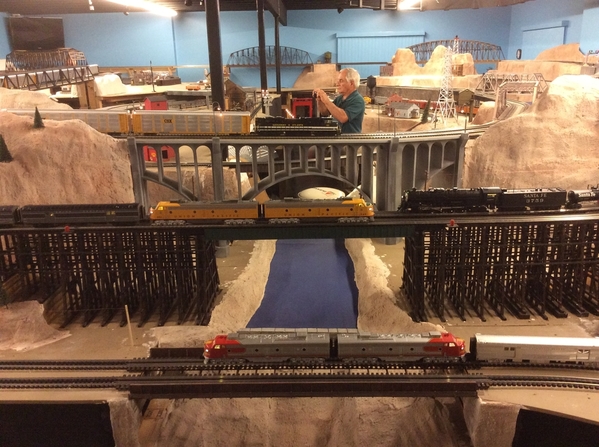
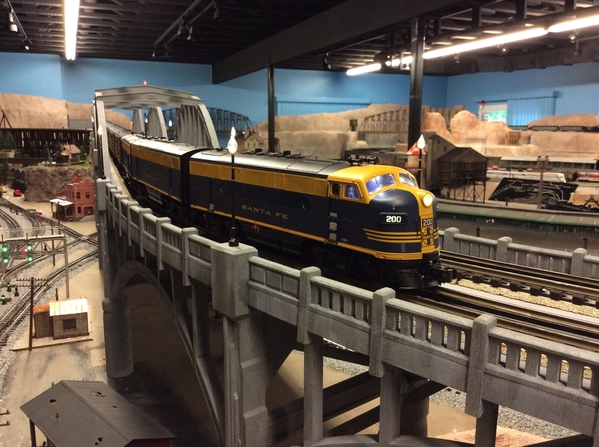
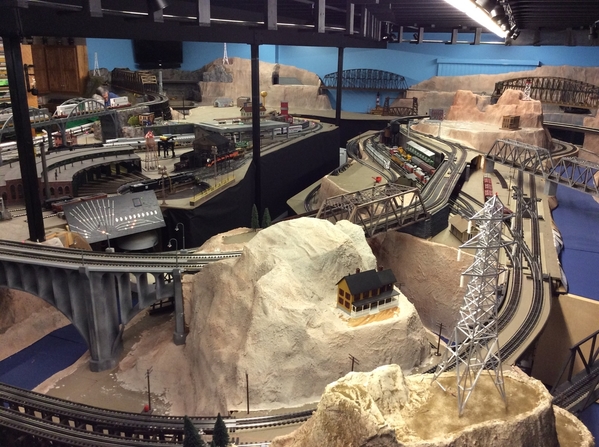
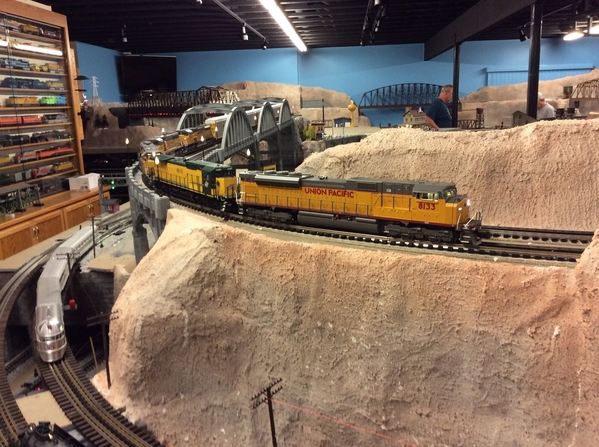
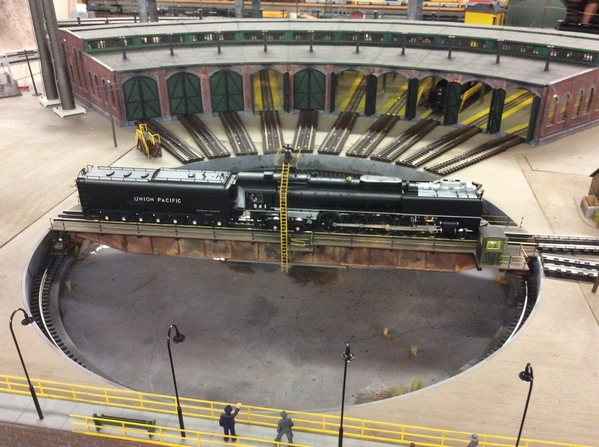
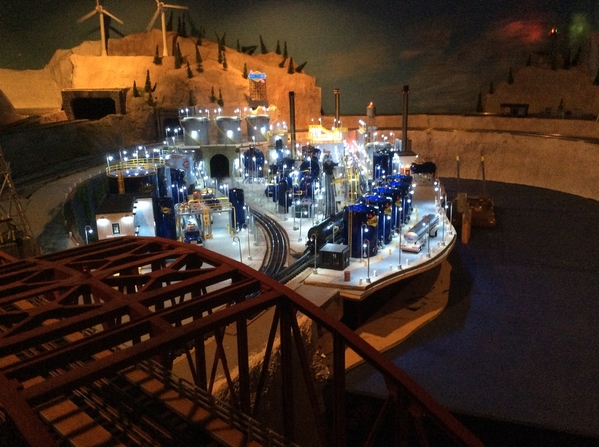
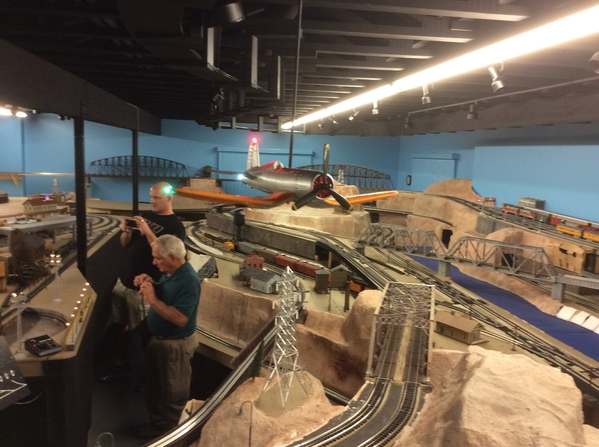
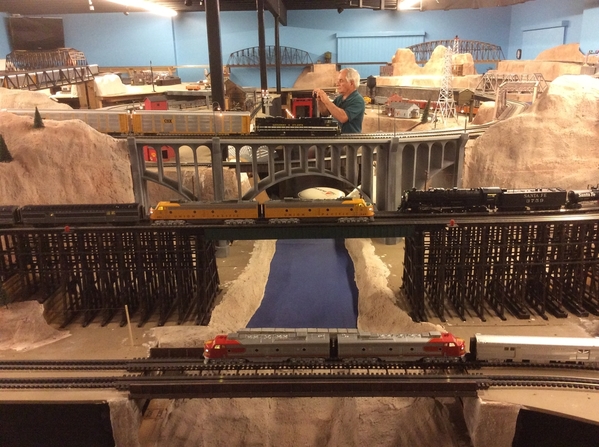
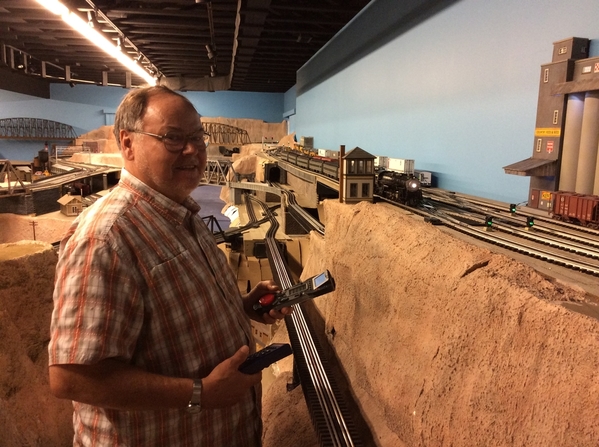
Attachments
Wow, 50 x 70, now that's a LAYOUT! ![]()
Hi Larry-
Thanks for posting all those pictures of FarmerJohn's huge layout!!! And the fact that the TMCC booster/ Buffer original design has been working so well on his 50' x 70' layout in Kentucky!! I can only imagine the length of time and number of people needed to get the layout to the point that was shown in your pictures!! Fantastic layout!!!
Carl J
Got my DM buffer, now looking for a place to put it, anxious to get it hooked up.
Thank you John
Ray
Hi Carl, Farmerjohn has been working on this layout for probably 7 or 8 years, with a really great wood worker and Friend. He works many hours daily on this adventure and keeps everything clean as can be. They have devised many neat features on his wonderful layout. 10 stall roundhouse with individual opening doors. A MILLHOUSE 34 inch TT. A signal system overhead signals, track level signals. A wonderful Oil Refinery, and new Mining System, above and below ground. One feature is 4 or 5 trains can be running and there’s is no way to figure out their route. Amazing thinking, and a fun to visit friend. Always something new to view and enjoy. He runs TMCC- Legacy Cab1L, Cab 2.....His wide radius curves, 0120 and more, no less than 080, allows for long freight and passenger trains to interwind with each other. Thank you for your comments and someday, come to see us. 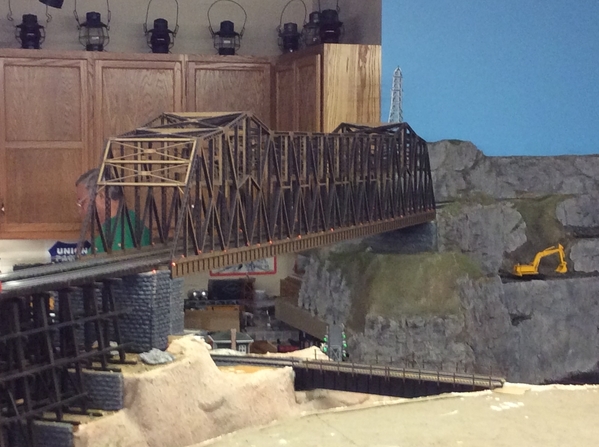
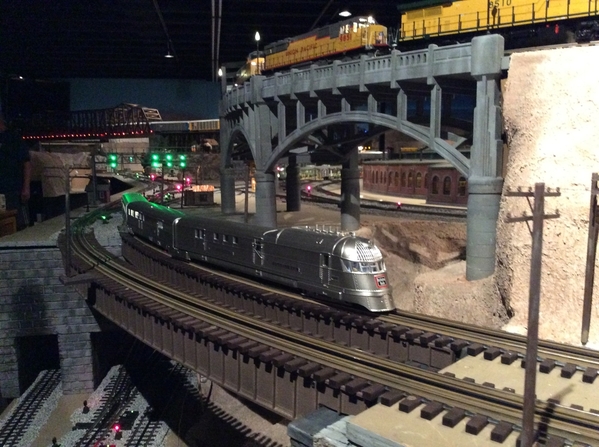
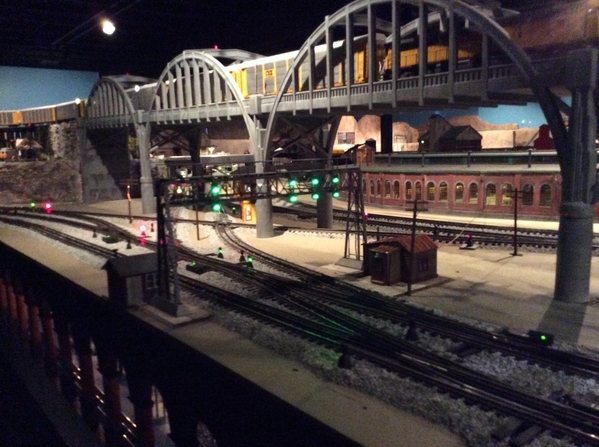
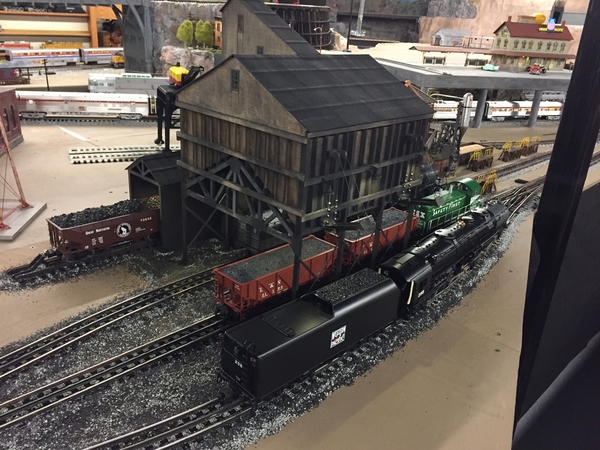

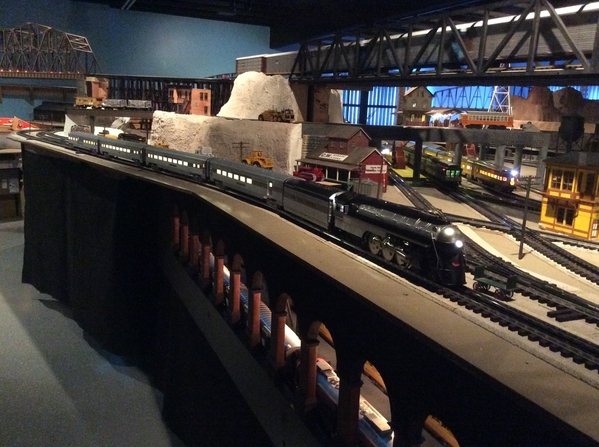
Attachments
That's the kind of layout most of us can only dream about. ![]()
I really have to thank John again for pursuing this project and carrying on where Dale left off. I also want to thank him for donating back in Dale's name. It's just another reason I find most train people are mostly made up of the good stuff.
Speaking of that, I almost have all the payments in and the buffers shipped, so I will be sending out the contribution in the next few days, I'll post when it's completed.
I'd still rather have Dale around to see his great project finally cross the finish line.
leapinlarry posted:I received my TMCC Buffer, however, haven’t installed it, but, I do have a HUGH SUCCESS Story, Farmerjohn, a Kentucky friend of mine, has a really large layout, 50 by 70, with an an adjoining room, who has had multiple signal issues, running TMCC/Legacy, Atlas O. Third Rail/Sunset Models, through many bridges, multiple levels, says All his engines Run Fine Now, Do to the TMCC Buffer. Dale Manquin came to visit me here in Tennessee in 2007, prior to York, and we went to see many layouts, one being Farmerjohn’s in Kentucky. Dale was a very fine gentleman and stayed at my home for a week. We had a great visit. I congratulate Gunrunner John for taking his concepts and making this wonderful product available to us Operators. Thank you John....I will install my Buffer in the next few days. Happy Days are here again. (Pictures are of Farmerjohns latout)
Look at that scene! In the famous words of Mr Barone, "HOLY CRAP!!!"
And as mentioned a big thanks to John for seeing it through to completion for all of us!
Larry,
thanks for posting the additional pictures and comments on FarmerJohn’s layout. The pictures continue to blow me away!!
Do you know where the TMCC signal was originally weak or intermittent and did the newly designed Buffer/ Amplifier installation immediately resolve all the operational TMCC signal issues?? I hear from others that track going across bridges or going through secenery made with wire screen or track going over / under other tracks are “weak signal points “ that seem to get solved with the TMCC Buffer??
Carl J
Carl J, the answer, from what I am hearing from Johnny, he gets a great signal in the entire room and the adjoining room now. Before the Buffer, only partial TMCC signal intermittent in the main room, but would allow some trains to run ok, others not ok, however, no legacy signal in the adjoining room. Its very discouraging to buy a top of the line Locomotive, or Diesel and it not run good do to signal. This is the best answer I can give you until I go to visit Johnny. Now he can run everything that’s TMCC/Legacy with great control anywhere in his train room. This TMCC Buffer is the best thing, since sliced bread.....
Another satisfied customer! Connected the DM TMCC Buffer and got a green light! ALL my TMCC/Legacy engines run everywhere on my 1000 sq. ft. multi level layout. I had talked to Dale about the buffer before he died and I am so appreciative to gunrunnerjohn for picking up the project. The recognition given to Dale is so appropriate.
Don
The larger the layout, the more benefit you can expect from the DM TMCC Buffer. It's good to hear success stories. ![]()
Thanks Larry!!
John, hooked mine up 10 minutes ago and the indicator light is green. Hooahh.
Put the loco I had the most signal problems with, blinking lights, stopping, etc., my Lionel UP Veranda.
It runs perfect through all the previous problem areas.
Thank you John and Dale.
You have turned my problem locos into great performers.
One question, can I leave it powered up 24/7 or should I turn it off between operating sessions?
Getting some encouraging feedback. I hope the kit we be available soon, with a candidate to assemble mine! Of course for a fee.
Jeff, other than using a few watts of electricity, I can't imagine why you can't just leave it on.
ironman1 posted:Getting some encouraging feedback. I hope the kit we be available soon, with a candidate to assemble mine! Of course for a fee.
I'm actually gathering parts for the kits, and I have the PCB blanks already. We'll have a solution for folks that missed the first production run. I just have to figure how they'll be packaged. Right now my thinking is that I'll prep the cases as I already have the tooling to do that, and individuals would probably take a lot more time to drill the holes in the proper places as well as make the slots, etc.
There will be an option. ![]()
Hi John,
Thanks again for this project. I just hooked the buffer up and got a RED light. I did run some engines that were always susceptible to interference like my K-line 2-6-6T and it had NO flicker at all with good response of commands.
The readings I got were: base signal - 1.085, output signal - 10.37. Any thoughts on what I should do/check?
Thanks,
Greg
The base signal is low (reason for the red light), but the output is uncharacteristically high. Based on your input, the output should be about 3.6vdc.
Something wrong with your metering? And things run better because 3.6 is an improvement.
Gregcz1 posted:Hi John,
Thanks again for this project. I just hooked the buffer up and got a RED light. I did run some engines that were always susceptible to interference like my K-line 2-6-6T and it had NO flicker at all with good response of commands.
The readings I got were: base signal - 1.085, output signal - 10.37. Any thoughts on what I should do/check?
Thanks,
Greg
First off, is this a Legacy or TMCC base? The TMCC base will usually get a red light and a few of them get the "no light". A good Legacy base should give you a green light.
I agree with Chuck, something is very wrong with the readings, with a known good Legacy base I got 1.88 volts DC for the Base DC reading and 5.4 volts for the Boost DC reading. Given the circuitry there, that's about what you should see. 10 volts on the Boost DC reading is knocking on the door to impossible! What kind of meter are you using?
I have a question about the light being red for lower output. What is drawing down the output signal 3.810volts to the track? When I unhook the track wire I get a green light and 6.15 volts out of buffer.
I'm confused. The lights are telling you what the base track output is doing, not the buffered output. If you're using the buffer, you shouldn't have the base track output connected to anything but the buffer input!
I'm getting 2.077 Base INP and 6.85 Boost OUT. I looked right down into the blue LED and after a half hour I can see again ![]() . So I ground the tops of the LEDs off on the sander. Diffused now.
. So I ground the tops of the LEDs off on the sander. Diffused now.
Thanks again John. Great stuff and hard work for you. I appreciate you.
gunrunnerjohn posted:I'm confused. The lights are telling you what the base track output is doing, not the buffered output. If you're using the buffer, you shouldn't have the base track output connected to anything but the buffer input!
The instruction is an excellent pictorial of the hookup. That should clear things up for him.
I have to admit, the clear LED's were possibly a mistake, those suckers are bright! ![]() I wanted to make sure they could be seen, I guess I did accomplish that goal.
I wanted to make sure they could be seen, I guess I did accomplish that goal. ![]()
They're fine. I thought about little opaque booties...or maybe an opaque lens snapped into the enlarged holes. But the sanding tamed them right down.
Well opaque booties would seem to really tone them down, easier would be black electrical tape. ![]()
![]()
Sanding the ends will certainly diffuse the light and save the eyes, probably the easiest method. ![]()
Hi John
I got the green lite and as Leapin Larry said earlier engines are running great where they never did before. I've gotten out old TMCC and they have no problems. My readings are off though 1.67 on the base DC 1.15 on the Boost DC, its an old. craftsmen multimeeter. Its plunged. Into my Legacy. Base
gunrunnerjohn posted:Gregcz1 posted:Hi John,
Thanks again for this project. I just hooked the buffer up and got a RED light. I did run some engines that were always susceptible to interference like my K-line 2-6-6T and it had NO flicker at all with good response of commands.
The readings I got were: base signal - 1.085, output signal - 10.37. Any thoughts on what I should do/check?
Thanks,
Greg
First off, is this a Legacy or TMCC base? The TMCC base will usually get a red light and a few of them get the "no light". A good Legacy base should give you a green light.
I agree with Chuck, something is very wrong with the readings, with a known good Legacy base I got 1.88 volts DC for the Base DC reading and 5.4 volts for the Boost DC reading. Given the circuitry there, that's about what you should see. 10 volts on the Boost DC reading is knocking on the door to impossible! What kind of meter are you using?
My "control" system is a Legacy Base which is also hooked up to a TMCC base. My testing meter is a Sperry DM-4400A. Now, today, I just retook the measurements and got .918 for base signal and 3.63 for Boost signal (but that reading was where it finally stop dropping after a minute originally registering at 4.2 v.
I disconnected the command base from the Legacy Base and got similar readings.
Does this mean my Legacy Base is faulty? If so, is there anything I should look for to fix or must it be returned to Lionel?
Thanks,
Greg
The lights and the DC output voltage are a very simple rectifier circuit that then feeds the DC output terminal and a voltage divider to drive the bi-color LED. In my testing I verified the actual input base voltages that the would trigger the red and green lights. I spot checked some of the buffers DC outputs, though given the light performance, I didn't expect them to be off. The red light starts coming on right as the base PP signal goes below 4 volts, and the green light starts to illuminate around 5.26 volts. Those numbers typically varied by around 5%. I will say, if you get a red light with a Legacy base, I'm 99% sure you have a low signal output that should probably be addressed. The only way to be sure is to measure the actual command base output signal.
All the voltage measurements were done with a Fluke 8012A bench meter, the 'scope measurements were done using the ATTEN ADS 1102CAL digital 'scope. The test "base" signal was 455khz from an HP 3311A Function Generator. In the development, I verified the operation with a couple of the original TMCC bases, one BASE1L, and a couple of Legacy bases. That was to insure that my test setup would reflect the real world. Obviously, I couldn't use a real command base for the actual production testing as I had no reliable way to vary the voltage from the base to test the buffer response at various signal levels.
I remember that Dale had spent significant time talking about the measurement using a similar diode circuit and in fact was including a cheap HF multimeter to get consistent results with every kit he produced to measure the TMCC/Legacy base output voltage.
I'm thinking maybe we need an independent cheap TMCC/Legacy test board just to verify the actual output of the command bases.
"I'm 99% sure you have a low signal output that should probably be addressed."
How do I do that?
I am sure it is the Legacy Base, because I hooked up the buffer to the TMCC Command base and the buffer flashed green for a quick second and then went out. So that seems to be "behaving" the way you described.
Well, Lionel is the folks that can address low output of the Legacy base. If you know someone with a 'scope, you can measure the output objectively.
I thought to further this discussion, I'd post a few waveforms that illustrate how I tested and why I felt the signal generator was a suitable replacement for the command base to test the buffers. ![]()
As you can see, all of the bases and my test generator put out a similar clean waveform.
HP 3311A Function Generator Output
Good Legacy Command Base Output
Bood TMCC BASE1 Command Base Output
Attachments
Gregcz1 posted:"I'm 99% sure you have a low signal output that should probably be addressed."
How do I do that?
I am sure it is the Legacy Base, because I hooked up the buffer to the TMCC Command base and the buffer flashed green for a quick second and then went out. So that seems to be "behaving" the way you described.
I've seen a couple "low output" Legacy bases. I don't know what is fragile on their output circuit, but Lionel can and does fix it free.
If were looking for a low cost handheld oscilloscope to measure the output signal of either a Legacy Base or TIU would this $25 one work??
New Assembled DSO150 2.4 inch LCD Display Digital Oscilloscope with Probe
Obviously, the ATTEN one would work fine, but the DSO150 doesn't have the bandwidth in reality. You want a bare minimum of 10x the sampling rate of the signal you're measuring, and the sampling rate of the DSO150 is 1Mhz, a 2x sampling rate.
The ATTEN is very similar to the one I use, AAMOF, I suspect it's the same one with slightly different panel markings. All the controls look identical as well as the bandwidth and sample rate.
Attachments
And the DSO150 has an analog bandwidth of only 200 KHz. I have a DSO 068 which is a great little handheld OScope and has a bandwidth of about 3MHz with equivalent time sampling rate of 20MHz which would work for this repetitive waveform. It’s a kit, so it’s even more fun...but there are similar non-kits if that kind of fun is not in your desires. JYE Tech is the company.
Yep, but I have to say, if you're going so spend $70-80 and hours of construction for a kit 'scope, why not spend $200 or so and have a 50mhz dual-trace 'scope? There are a lot of times I find the dual trace to be very useful, and wish I had even more traces. ![]()

Attachments
Got everything wired up got the green. I have two questions, 1 do I need to have the legacy base above the track level and 2 can I link the TMCC base and the Legacy base together? Thanks Bill
Billsrr posted:Got everything wired up got the green. I have two questions, 1 do I need to have the legacy base above the track level and 2 can I link the TMCC base and the Legacy base together? Thanks Bill
The only thing having the Legacy base above track level or line of sight is base to remote communication is better.
The TMCC base and Legacy base being connected via the supplie Y cable that came with Legacy should have zero to do with the booster. When connected like that, the TMCC base sends its information serially to the Legacy base. The Legacy base then sends that info to the track. Do not connect both Legacy base and TMCC base to the track or booster from the U connection. Just the Legacy base.
The only other precaution is not to put the buffer right next to the Command bases, give it a few inches of space. Also, don't bundle the buffered track signal and the TMCC/Legacy base signal, I had a report that caused crosstalk and scrambled the signal. Since they're in phase and one is three times the amplitude of the other, I can easily see how that could build yourself an oscillator if there's enough of a run right next to each other. ![]()
gunrunnerjohn posted:Yep, but I have to say, if you're going so spend $70-80 and hours of construction for a kit 'scope, why not spend $200 or so and have a 50mhz dual-trace 'scope? There are a lot of times I find the dual trace to be very useful, and wish I had even more traces.
Yes, good point. I buy kits for kit fun. I have a Rigol that looks like your scope for daily use. Also a Tek 2215 on a cart for easy use off the bench.
I really like the Rigol line, if I had it to do again, I might spend the extra $100 and get one of those. OTOH, my ATTEN has worked well and does everything I need it to do. Of course, I would like four traces at times, but I'm not willing to pay for them. ![]()
MartyE posted:Billsrr posted:Got everything wired up got the green. I have two questions, 1 do I need to have the legacy base above the track level and 2 can I link the TMCC base and the Legacy base together? Thanks Bill
The only thing having the Legacy base above track level or line of sight is base to remote communication is better.
The TMCC base and Legacy base being connected via the supplie Y cable that came with Legacy should have zero to do with the booster. When connected like that, the TMCC base sends its information serially to the Legacy base. The Legacy base then sends that info to the track. Do not connect both Legacy base and TMCC base to the track or booster from the U connection. Just the Legacy base.
Thanks, Does that mean that I wont be able to use the cab 1's.
It means you can use the Cab 1. The Cab 1 talks to the TMCC base and the digital output (DB9 connector) from the TMCC base goes into the digital input (DB0 connector) of the Legacy base. Then the Legacy base sends the signal out to the track...or in this case to the booster and then to the track.
Not at all Bill. When you connect the BASE1 to the Legacy base, that enables the CAB1 to send commands over to the Legacy base and out to the track. The buffer doesn't change any of that wiring, just leave it as is.
- The only thing you do to install the buffer is remove the wire to the track from the Legacy base and connect track to the buffered output.
- Connect the legacy base track output to the buffer input.
- Finally, install the tether and connect the loose wire to the Earth GND on the buffer.
The buffer is installed ready to do, plug it in and away you go.
The cab one controllers don't function only the legacy remote. Cable between the legacy and tmcc base are connected and buffer is wired up as described. also new batteries in the cab one remote. Any ideas.
Good, news, I installed the DM Buffer and all the weak signal issues in the freight yard are gone! But there is some interesting news. First a little about the layout for background. It is S gauge, about 800' of track on 4 levels, 4 reverse loops with electronic auto reverser boards. Power is 8 independent power districts, each fed by one handle of a pair of ZW-L's. One Legacy base, 37 LCS modules. There are about 40 blocks spread across the 8 power districts, each block has both rails isolated since it is 2 rail. There are 25 .1microfarad capacitors across the 2 rails to assure all blocks have the Legacy signal on both rails. All the track has aluminum tape under it for good signal.
When powered up the indicator appears solid red with flashing green. It flashes green irregularly but about 5 flashes/second. Voltage measures about 1.5V in and 3V out. Works that way with any one or all of PD's one through 7 powered up with voltage on the rails. The Legacy signal is perfect all over the layout. When I power up PD 8, singly or with other power districts the indicator goes solid green, the output voltage jumps to 15V, then over about 10 seconds it slowly ramps down to 11V and stays there. The input voltage does not change. What is really interesting is all the occupied track blocks in PD8 are unpowered at this point when I measure this high output voltage because the BPC2's controlling them are off. The trains run perfectly all over the layout. PD 8 is a 6 track passenger yard, an 8 stall roundhouse, 3 turntable feeder tracks and the rails on the TT. My initial thought was this is related to the auto reverser board that feeds power to the TT rails but thinking more about it I do not feel that is possible. As long as the system keeps working I am not going to worry about it but it sure is puzzling.
I have a second higher quality meter I need to find to get a second reading of the absolute voltages, but the voltage out definitely increases based on the indicator light.
The changing of the signal based on which power district is enabled sounds like there is some continuity between earth ground and the track, can't imagine any other reason. I don't understand what the the issue with the TT is, why do you need a special "auto reverser"?
Billsrr posted:The cab one controllers don't function only the legacy remote. Cable between the legacy and tmcc base are connected and buffer is wired up as described. also new batteries in the cab one remote. Any ideas.
Move the buffer away from the TMCC command base. Perhaps you're getting interference with the stronger track signal?
BILLSRR: I had the same problem, Legacy control worked but my Cab-1's weren't responding. I wrote to GRJ, he recommended I move the CAB-1 Base unit... I ended up having to move it several feet, and down near the floor, but then it started responding to commands from my CAB-1 and flashing the red light on the CAB-1 base indicating it was getting a command.... Everything is working great now, both my CAB-1's and my CAB-2 controllers.... I would assume when your CAB-1's "aren't working", you're not getting any flashing red light on the CAB-1 Base when you attempt any control with the CAB-1 Controller ??? that was my situation.
In 2 rail an auto reverser system is needed because when the TT rotates 180deg the right rail becomes the left rail and vice versa. In 2 rail a TT becomes its own reverse loop. In 3 rail the center rail is always the center no matter which way the TT track is aligned. Same reason I have all these relays to change which wire powers the frog when the turnout is thrown.
I did some additional tests with a better quality digital meter. Without any of the tracks powered I read 1.3V input and 3.6V output. This time I turned on all the track blocks so there was plenty of load with engines and passenger cars. When PD 8 is turned on The output voltage jumps to 13.5, then drops to 11.5 as before. With the better digital meter I see the input voltage jumps from 1.3 up to 1.7V and stays there.
I need to investigate your idea there is a connection somewhere between earth ground and the track. With the input voltage change that is the most likely cause. In the interim, the system is working.
Gregcz1 posted:gunrunnerjohn posted:Gregcz1 posted:Hi John,
Thanks again for this project. I just hooked the buffer up and got a RED light. I did run some engines that were always susceptible to interference like my K-line 2-6-6T and it had NO flicker at all with good response of commands.
The readings I got were: base signal - 1.085, output signal - 10.37. Any thoughts on what I should do/check?
Thanks,
Greg
First off, is this a Legacy or TMCC base? The TMCC base will usually get a red light and a few of them get the "no light". A good Legacy base should give you a green light.
I agree with Chuck, something is very wrong with the readings, with a known good Legacy base I got 1.88 volts DC for the Base DC reading and 5.4 volts for the Boost DC reading. Given the circuitry there, that's about what you should see. 10 volts on the Boost DC reading is knocking on the door to impossible! What kind of meter are you using?
My "control" system is a Legacy Base which is also hooked up to a TMCC base. My testing meter is a Sperry DM-4400A. Now, today, I just retook the measurements and got .918 for base signal and 3.63 for Boost signal (but that reading was where it finally stop dropping after a minute originally registering at 4.2 v.
I disconnected the command base from the Legacy Base and got similar readings.
Does this mean my Legacy Base is faulty? If so, is there anything I should look for to fix or must it be returned to Lionel?
Thanks,
Greg
I just realize that I get the 10 volt readings when the transformers supplying the track power are turned on. Is that normal?
It shouldn't affect the readings at all, if you're seeing that, looking at the schematic of the buffer, I'd suspect that somehow you're getting a 60hz voltage differential between earth ground and the outside track from the transformers. When I do this on my test layout, I see no variation of the DC monitoring voltages regardless of the transformer setting. Even introducing a 100 ohm resistor between earth ground and the buffered output, I don't see a significant change, just about a .2 volt jump. I'm using a TMCC base, and I'm getting 1.25V base and 4.14V boost.
In short, I don't know what's going on. ![]() With 2-rail, a lot could be different, I have very little experience with TMCC/Legacy on 2-rail of any scale.
With 2-rail, a lot could be different, I have very little experience with TMCC/Legacy on 2-rail of any scale. ![]()
John, one of the reasons I posted some of the details is I was thinking I might be the only purchaser of the buffer with a complex 2 rail layout. Dale himself was curious about differences with a 2 rail layout. We were in communication about 3 months before his passing, making plans for a visit with his prototype and test equipment. He lived about 1 1/2hours north of me. Unfortunately that never happened.
In 2 rail there is no outside rail electrically speaking. Either of the 2 rails can be connected to the common post or the 0-18V variable post depending on the last action of any or all of the reverser boards. These boards actuate by sensing the short circuit current when the lead truck crosses a reverse loop junction. I will post a picture of one. Unlike the DCC version, in high current AC applications there is quite a visible spark before the board reverses the connections. The only other difference I can think of in 2 rail is the use of .1microfarad capacitors connected across the 2 rails for the Legacy signal. 25 of these cannot be enough to affect anything.
I will figure this out, due to the size and large number of connections it may take some time. The good news is every wire runs through terminal strips and all have spade lugs on the wire ends so removing and replacing any connection is easy, there are just A LOT of them. I also have all the wiring diagrams with the color codes and all the track feeder locations with the rail gap locations.
Capacitors across the rails shouldn't affect anything as they're not affecting the earth ground, or at least they shouldn't be. Dale had a lot move testing under his belt with the buffer, one more reason it's a true shame he isn't here to see this project to the finish. He'd also probably have a better idea why you're seeing what you're seeing.
legeacy base with low output boost (.800volts) I called lionel to return and they said to reset channel and try. And should not have any other controller base connect to track. The other strange thing I noticed was when I unhooked my ground plane from the water pipe My reading on my cab-L increased and I now have no light instead of red with a voltage of 4.29 boost out
Did changing the channel have any affect or just disconnecting the ground plane wire?
The channel should have NO effect of any kind on the track signal. You may have stray voltage on the water pipe. If the command base is going to earth ground through the 3-prong outlet, the recommendation is NOT to try to add an earth ground! Many times there is a voltage differential between the outlet ground lug and a waterpipe ground.
Changing channel had no effect on legacy base still no output . Ran the trains over all problem areas of layout today and everything is working great. I am using my Cab 1-L now.
Sounds like the Legacy base may have a problem. I'd not tinker with the water pipe ground, stick with the outlet ground.
chris a posted:BILLSRR: I had the same problem, Legacy control worked but my Cab-1's weren't responding. I wrote to GRJ, he recommended I move the CAB-1 Base unit... I ended up having to move it several feet, and down near the floor, but then it started responding to commands from my CAB-1 and flashing the red light on the CAB-1 base indicating it was getting a command.... Everything is working great now, both my CAB-1's and my CAB-2 controllers.... I would assume when your CAB-1's "aren't working", you're not getting any flashing red light on the CAB-1 Base when you attempt any control with the CAB-1 Controller ??? that was my situation.
Thanks I moved the TMCC base down to cable limits and moved the buffer up and all things working, I didn't know anything about the signal led on the Tmcc base. I will look at that. Sure is nice to have all of you out there to help.
For some reason in certain configurations, the buffer being right next to the TMCC base can cause issues. I tried that here, and I had no issues at all, even when I was controlling a train from another room with the old TMCC BASE1 and CAB1.
Ok, 1 quick Question, The Legacy charger that came in the Legacy Set is Not to be plugged into the electrical outlet, just the New DM TMCC Buffer plug goes into the electrical outlet? From the diagram, it’s not shown plugged in....Thanks for anyone reading this question. Thanks, Happy Railroading....
You connect the Legacy system EXACTLY as before to power! That was an oversight in the pictures, but clearly you need the Legacy command base to have power! The tether that is supplied just goes between the Legacy brick and the command base to tap off the earth ground for the buffer, the earth ground for the Legacy base comes through the Legacy brick's ground pin.
Hey John, here down at AGHR in LA, the buffer was installed a week ago. While the red light is on the buffer, previous bad signal areas have been resolved. Swapped out the Legacy base with another and LED was still red. Before we take any further action, I will have Adrian evaluate the situation. BTW, Adrian is on assignment in New Mexico for NASA and hopefully will be back soon. We miss him!
I suspect for whatever reason you're not getting the more than 5V to light the green indicator. The red indicates you're getting 4V P-P or less, that's not what a good Legacy base should be doing.
Just for yucks, disconnect the track signal from the buffer and see what the signal indicator does with the base connected to the buffer. It shouldn't have an effect, but who knows.
The red light is strictly checking the base output, it doesn't have any connection on the output side of the buffer. Since the buffer could be driving any kind of load, it was pretty hard to pick a number for what voltage you should see out. I figured it was more important to know if the base was having an issue as that's far more likely, the buffer is a pretty simple circuit and should be very robust. There's also nothing to adjust, it just does it's job.
Thanks for the reply John. I will be at the club tomorrow and forward the readings with and without the track signal connected to the buffer.
Jeff
Jeff, let us know what the lights are doing as well.
Will do John
Jeff
Lionel has my legacy base for low signal output repair. I have been testing my layout with my cab1-L and with no signal light on I am getting 4.0 boost out and all my problems are gone. When I hooked up my ground plane grid just to the wall ground instead of the water pipe I picked up 0.2 volts boost. When I unhook the boost out to the track I get a green light and 6.15 volts boost. Is there a simple answer to the drop in voltage when boost is connected. If I removed all trains off the track will boost increase?
First off, lose the water pipe ground and use the outlet ground only. My guess, based on what you're seeing, is there is a voltage differential between the water pipe ground and the electrical panel ground.
The base input drives the signal lights, the thing that is most likely to affect their operation on the boosted output side is anomalies with the earth ground circuit. If you totally overload the buffer with a huge load between the earth ground and track signal, the measured voltage will rise slightly on the base signal as the amplifier circuit goes kinda' crazy when it's really overloaded. In a normal layout, this should never be an issue unless there is some significant wiring issue. When I put a massive overload on the buffer, I get a pretty crazy looking signal! However, in this case, I can't imagine the command base being able to drive the same layout!
The upper trace is the buffered output signal, the lower trace is the base input signal. Please note this is NOT a normal behavior, only when the buffer is overloaded way past it's maximum power output rating.

Attachments
Hey John. Just disconnected the track signal from the buffer. Indicator light turned green! Measurements were 1.87 and 6.2. Seems good to me. Upon reconnection light back to red? Yuck! What’s do think is going on?
Jeff
I'm somewhat at a loss, but I think if you can find someone that has an oscilloscope, you could check what the output looks like before and after connecting to the track.
Most people are connecting this and Shazam, great signal. However, a couple are having a similar issue, so it would be nice to figure out what would cause this to happen. It's a bit confusing if the command base is able to drive the layout.
Can you describe EXACTLY how you have this connected?
Ok, we hooked up the new TM Buffer to my layout yesterday, as described. The blue and green lights worked. We did disconnect the earth ground plane from the center receptacle outlet. All seemed ok, however, today, it did not work after 20 minutes of operation. The Cab 1 worked ok for a bit. The Cab 2 also worked for a bit. The breakers were going off. Now, after I reboot, the system comes on for a few seconds and then shuts off. Everything is Lionel Legacy, connected per directions. The Legacy cradle lights up, the Cab 1 base has the red light on. Where do I start to Correct this issue.
John,
Just adding my two cents in case it helps you troubleshoot with other red-light issues.
I believe my problem is a poor signal from the base. I disconnected Dale's "serial booster" and got the "red light" and taking the ground/base measurement off of the buffer the Volts drop immediately starting around 3 and continue to drop...holding it there long enough it slowly crept all the way to 0 and came back up but never above 1 volt.
When I plugged the serial booster back in the reading crept up to and held steady at .5 volts.
I do get a green light when the track wire is disconnect from the buffer.
I've got the RA postage from Lionel, just waiting for good 'ol Florence to leave so I can send the base down to NC.
Greg
leapinlarry posted:Ok, we hooked up the new TM Buffer to my layout yesterday, as described. The blue and green lights worked. We did disconnect the earth ground plane from the center receptacle outlet. All seemed ok, however, today, it did not work after 20 minutes of operation. The Cab 1 worked ok for a bit. The Cab 2 also worked for a bit. The breakers were going off. Now, after I reboot, the system comes on for a few seconds and then shuts off. Everything is Lionel Legacy, connected per directions. The Legacy cradle lights up, the Cab 1 base has the red light on. Where do I start to Correct this issue.
First off, the breakers going off is a RED LIGHT. NOTHING in the buffer could possibly cause breakers to trip.
You need to first figure out what kind of power issues you have, because that can't be the buffer.
Gregcz1 posted:John,
Just adding my two cents in case it helps you troubleshoot with other red-light issues.
I believe my problem is a poor signal from the base. I disconnected Dale's "serial booster" and got the "red light" and taking the ground/base measurement off of the buffer the Volts drop immediately starting around 3 and continue to drop...holding it there long enough it slowly crept all the way to 0 and came back up but never above 1 volt.
When I plugged the serial booster back in the reading crept up to and held steady at .5 volts.
I do get a green light when the track wire is disconnect from the buffer.
I've got the RA postage from Lionel, just waiting for good 'ol Florence to leave so I can send the base down to NC.
Greg
Sounds like you indeed have some sort of issue with the command base. Also, the fact that the power is varying as you tinker with the serial connection sounds like you may have ground crosstalk on the serial connection ground pin. I'd get the buffer running without anything connected to the command base serial data port. If connecting something to the serial data affects the buffer, it would also affect the command base signal, and that should be hunted down and corrected.
Hi John
This buffer is the best thing that has ever happened to my layout. I'm. Running engines. That I was going to sell because they would stop with blinking lutes. They now run at super slow speeds all around my layout with no problems . I now have a layout that is fun to operate thanks to you and Dave. Thanks and Ill see you at York
Great, love to hear about successes. ![]()
John
We installed the Legacy booster on the TMB Club layout and VERY PLEASED to report signal increased by 3X and all is well. Bear in moind our club layout is over 4,000 SqFt
Thanks again for carrying Dales design through to completion
Steve
Glad to hear it, that's how it's supposed to work. ![]() Did you have any DCS interaction with it?
Did you have any DCS interaction with it?
Well today at the club, I disconnected the TMCC power master from the hookup. Voila, green light on the booster. Only limitations now is that we cannot use CAB 1 any longer. We have several Legacy remotes and a CAB1L. All is looking good. Thanks for all your help John.
Jeff
Odd that it affects the PowerMaster, don't know why that would be.
The PM is a load for the 455KKz? So come kind of choke in series would work?
I can't imagine how the buffer is affecting the PM, that doesn't make sense.
Have two old PowerMasters a powermaster bridge, a newer 360 powermaster. Everything works good with the buffer and Legacy Cab2 setup. I don't have a old TMCC base or Cab1 in the mix.
Hey John, I think that I misspoke. It was not the power master, It was the TMCC base that was disconnected. Hope this helps.
Jeff
sphillyj posted:Hey John, I think that I misspoke. It was not the power master, It was the TMCC base that was disconnected. Hope this helps.
Jeff
How was it connected?
Did you have both the Legacy base and the TMCC base connected to the outside rail? When using the Legacy base, the TMCC base is only connected to the layout using the Lionel supplied DB9 two into one adapter. Is that how it was or was it connected to the outside rail?
The buffer should have no effect at all on the serial connection between the TMCC and Legacy command bases.
The TMCC base is connected to the layout using the Lionel supplied DB9 two into one adapter. This is the suggested method.
As soon as i removed the power from the TMCC base, the buffer went bright green. Signal strength is right where it should be.
Go figure?
Jeff
Could it be that the TMCC base is somehow connected to a different ground (earth ground vs AC ground)? I'd look at a ground loop possibly.
dick
Something is certainly odd, that shouldn't have any effect. One thing you can do, since you don't need any TMCC signal from the TMCC base, isolate the ground pin from the power brick with a 3-2 plug adapter. See if that helps, if it does, Dick is probably right.
Some interesting findings today.
With the TMCC base out of the equation, I noticed that DCS was running very poorly. Many out of range messages, horn that did not turn off and many areas where there was just no response.
Then turned off All power to Legacy, TMCC base and buffer. DCS returned to normal and ran flawlessly.
After repowering including TMCC base, buffer light returned to red DCS again showed out of range messages continued horn blowing and general non response from remote BTW this was with both the remote and the Wi-Fi
Consulted with Adrian and he noted that there was some type of interference going on between the systems. Hopefully Adrian will return from his assignment soon and get to the bottom of it
Would love to hear any and all suggestions
Jeff
One thing I might suggest it to "tone down" the buffer output somewhat, while still keeping a lot of the benefit of it being used. Here's a simple way to "tune" the buffer output, see if this helps. I'd start with my suggested values, this returns the amplitude of the TMCC signal to near default, but still allows you to have a lower impedance signal to help drive the TMCC problem areas. You can then maybe change the resistors to 150 ohms each to give a small boost if the first one doesn't do enough for the TMCC. The resistors should be 1/2 watt or larger.
Adrian was talking about this, and I figured it would depend on exactly how the DCS was wired. I suspect a perfectly optimum wiring of the DCS might not have the issue, but if you have any signal degradation of the DCS signal, it may be more adversely affected by the boosted TMCC signal. Note that just because you got 10's for the signal test, that doesn't mean you have perfect DCS signal, it just means you have enough for solid communication with the locomotive.
Attachments
Good evening forum friends and helpers, as stated earlier, my entire system died. Today, I hooked up the Cab 1 System by itself, tada, it worked. (Without the Buffer). Then, I hooked up the Cab 2 Legacy System by itself, ( without the Buffer), and it was dead, the Cab 2 would not turn the layout On. I do not have electricity testers, what’s my next step. Just for your thinking, my layout is operated by 2 TPC’s 400)s, connected through the new Lionel ZW with 180 Watt bricks. With the Cab 1, everything worked fine. Thank you all for any ideas....
Obviously, I'm not sure what happened. The only thing I can think of is we had an instance of a short in the earth ground tether that blew the fuse in the Legacy power brick. If that is the case, we can replace it. However, with no meter of any kind, it's hard to determine if that's the case. The buffer operation itself is incapable of causing a failure of the Legacy base, so that's the only thing I can think of.
Thank you, how can I test the earth ground tether part only, to see if it was the culprit? Also, would this TMCC Buffer System work with the Cab 1 base, without the legacy system being connected? Thank you again.
Does the Legacy base power up at all? Do you see the lighted legends on the base when you plug it in? If no, maybe the earth ground tether is shorted. I tested all of them before shipment, but the connector design isn't the most robust, and sometimes things shift in use.
If the base doesn't light up at all, we need to test the brick, find a friend with a meter. It puts out 8-9 VAC FYI.
The lights come on the Legacy base, (cradle) come on, and there’s is blinking when I try to power up, it’s just not turning the track power on, like no signal. This is without the Buffer connected. I do have an electrical company in town that can test the tether. The Cab 1 base and Cab 1 remote work.
Well, if it didn't kill the fuse in the Legacy power brick, the tether isn't shorted. I can't imagine the buffer being able to damage the Legacy base, it just doesn't have the energy to do that. Something else has happened, though I can't imagine exactly what.
Thank you Gunrunner, I will get with Lionel tomorrow and get their ideas, I think this rules out any problems with the Buffer. One question, will this system work with the Cab 1 System alone?
Sure, lots of folks using it with the old TMCC BASE and CAB1, it works fine. It's actually how I did a lot of testing, I have an old TMCC base on my test bench.
The only thing you'll see different is the signal strength light will either be off or even red. However, if the base is working, it'll still work a lot better with the buffer. The Legacy base puts out a much stronger signal than the old TMCC base, and that's what the signal strength light is really calibrated for.
Thank you for the information, If the fuse had blown in the Legacy brick, would any lights come on in the cab2 Command base? Also, is there a reboot to the Legacy system?
Something like the tpc’s need breakers reset?
oh, never mind, it worked with cab 1...
Thank you Cjack, yes, the system works with Cab 1 Therefore making me think the TPC’s are working ok. So, the Legacy System, when used by itself, the base lights up, the lights also blink on the charger, the yellow light is on, but, the Cab 2 will not turn on the TPC’s to power up. Is this do to the fuse in the Legacy base? Thank you for any advice. Leapin Larry
leapinlarry posted:Thank you for the information, If the fuse had blown in the Legacy brick, would any lights come on in the cab2 Command base? Also, is there a reboot to the Legacy system?
If the fuse had gone, nothing would light, the base would get no power. The only "reboot" that I've ever known about for the Legacy command base is removing power. Did you try changing channels on the Legacy base and then searching for it with the CAB2?
No, but it’s great to know the fuse is not blown. I will start over with new channels, and double check my wiring. Thank you...
I only really follow in the fall through Christmas as my tree layout is the only space I currently have to set up trains.
So it looks like while I was in "hibernation" this opportunity came and went. Although the modest permanent layout I have planned eventually would likely not need this, I would have ordered one just to have.
So here's to hoping there may be a "second run" of this gadget at some point in the future. I'm not the sort to get a kit and create it from that, so I'll have to wait for now.
Ok, as suggested by friends, take the Legacy System away from the layout for simple/specific testing, TaDa, it works....Then I added the Cab 1 to the Legacy System, they both work, tada. So, now that I know my command control works, I will check out the power on the layout....Now, Progress is being made.. So, I am using a ZW w/TPC’s 2 only 400’s each with 180 watt bricks.
Ok, now, my system is up again, tada, reprogrammed the 2, ZW-C transformers, the TPC’s, everything seems to be working, Cab 1- Cab 2.... Tomorrow, after a thorough check out of all the wiring, I will install the DM TM Buffer....It just takes one step at a time, says my friend at the Madisonville Shops, to Win the race. If I were to give this problem a Reason to go down, “the cause of the shut down”, probably a derailment occurred somewhere on the layout......Happy Railroading...
Hard to say what happened, I'm glad to hear all your components appear to be working. ![]()
John, back on 9/10 I posted some info about the Legacy signal issue I was having on my 2 rail layout. I now have it fixed so I thought I would share the cause of the problem. You were correct it had to be some kind of ground loop issue. First just for info but not related to the problem, the layout power is supplied from a dedicated 20A circuit from the main panel. The house has 2 sub panels, one for inside circuits and one for exterior loads. The balance of the outlets and lights in the train room are supplied from the interior sub panel.
The layout was built with metal foil tape under all the track. All the foil tape is connected together and wired back to the main control cart with a single ground wire. The problem was this wire was connected to a ground pin in a power strip rather than to the proper Legacy base connection. There are 3 power strips on the control cart, power strip "A" plugs into the 20A outlet, "B" plugs into "A" and "C" plugs into "B". The 990 base is plugged into power strip "C", The new Buffer is plugged into "A" and the separate ground pin mentioned above was plugged into "B".
As soon as I unplugged the separate ground connection the buffer indicator turned steady green, the layout works perfectly with all engines working everywhere on the layout. I will ultimately connect the ground wire correctly but I need to disassemble some cable bundles on the control cart to do that. I like it when a fix is that simple. I am really surprised a professional layout builder made this kind of incorrect wiring connection for a Legacy system. Also, none of the unique 2 rail controllers have any effect on the system function.
I see the foil as the problem. If you had just used a wire for an additional antenna to transmit the TMCC signal, there would not be such a large capacitive load from the ground wire antenna to the base (connected to the rails) end of the signal. I think terms like "ground plane", etc. are unfortunate in that they give a wrong impression of the purpose of the antenna wire in the house wiring or as an added antenna wire on parts of the layout that may be shielded from the house wiring. The term ground loop does not apply either. It's simply too much capacitive loading I think.
Chuck is probably right. The buffer will drive quite a bit of capacitance, but there is a limit.
gunrunnerjohn posted:One thing I might suggest it to "tone down" the buffer output somewhat, while still keeping a lot of the benefit of it being used. Here's a simple way to "tune" the buffer output, see if this helps. I'd start with my suggested values, this returns the amplitude of the TMCC signal to near default, but still allows you to have a lower impedance signal to help drive the TMCC problem areas. You can then maybe change the resistors to 150 ohms each to give a small boost if the first one doesn't do enough for the TMCC. The resistors should be 1/2 watt or larger.
Adrian was talking about this, and I figured it would depend on exactly how the DCS was wired. I suspect a perfectly optimum wiring of the DCS might not have the issue, but if you have any signal degradation of the DCS signal, it may be more adversely affected by the boosted TMCC signal. Note that just because you got 10's for the signal test, that doesn't mean you have perfect DCS signal, it just means you have enough for solid communication with the locomotive.
Last time I was in civilization we had a good 10-12V DCS swing everywhere on the layout, but we were somewhere around 1/3 to 2/3 capacitive imbalance inner to outer rails meaning the 450KHz will show up across the DCS differential voltage at 1/3 of the amplitude it has to Earth ground. I may try to hack the driver stage on your buffer to drop the voltage gain while maintaining the low output impedance.
We had an accident on the launch line so we're being encouraged to scrub. I may be back working on this buffer sooner rather than later.
Dropping the voltage gain would be simple, just change the resistor value. ![]() If you don't already have them, here's the schematic for the current SMT version of the buffer. The upcoming thru-hole version schematic is identical, the component ID's remained the same.
If you don't already have them, here's the schematic for the current SMT version of the buffer. The upcoming thru-hole version schematic is identical, the component ID's remained the same.
Attachments
Yes, I see a gain of 3.3. I thought maybe a 2K pot in series with the 1K resistor, but it was just a thought when I was looking it over. My layout is not that big and I, so far, mostly like seeing the health of the base when I see the green light.
BTW, that schematic is not clear as the other ones you posted. Just wondering if the res is limited somehow.
This morning I made a temporary connection between the foil tape under the track and the earth ground terminal on the Buffer. The green indicator remained on and got slightly brighter. Completely different behavior than when the foil tape was connected separately to the ground in the house wiring through the power strip. There is some capacitance added with the foil tape under the track but apparently not nearly enough to affect the Buffer. The original problem was caused by the independent connection to the house ground. After I reroute the wiring on the power cart to make this connection to the Buffer Earth ground terminal permanent I will take some new voltage readings.
The connection from the foil tape to the Buffer earth ground terminal is now permanently installed. The voltage readings are 2.7V and 8.05V. The indicator is a bright solid green, all the engines are working as they should. The installation is finally complete.
You have booming signals, shouldn't be an issue now!
The independent connection to earth ground is a big problem, as you likely get ground currents that will cause all sorts of issues.
Not sure if this will help anyone, but figured I should post it. I am running my original TMCC base unit and the Legacy Base. Initially, I always got a bright green light from Day 1. After initially hooking it up, the Legacy worked great, TMCC was not getting commands from the CAB-1...
Wrote to John, he told me to move the TMCC Base Unit further away from the Legacy Base and the Signal Booster, which I did. Voila, everything worked great.
At that point, my Legacy control power transformer was plugged into a 3 prong grounded extension cord which was plugged into the same grounded duplex (2 plug receptacle) that the Large Power Strip with surge protection was plugged into.... The TMCC base unit, ZW-C transformer, other PW ZW and my DC power pack for signal control were all powered through the Power Strip with Surge Protection.
As I am never happy to leave "well enough alone" I decided to get a splitter for the extension cord and plug both my Legacy and TMCC transformer into that grounded extension cord bypassing the power strip.
Ironically, I went down to run trains the other day and my CAB-1 wouldn't work, looked down at the base unit near the floor, and it was not getting any signal from the CAB-1. No red blinking light when you push any command function !!!!
So, it took me a day or two to think about it, (yes I am slow).... and plugged the TMCC base back into the surge protected power strip that everything else is powered from. That was the problem, The CAB-1 and the CAB-2 are both running great !!!
I don't pretend to understand why, but I am glad I am back to having both systems playing nice together in the sandbox !!!
The signal booster is absolutely great, I definitely had some trouble spots and areas where headlights flickered and commands were unreliable, NO MORE ..
Thanks John.... Chris A
chris a posted:Not sure if this will help anyone, but figured I should post it. I am running my original TMCC base unit and the Legacy Base. Initially, I always got a bright green light from Day 1. After initially hooking it up, the Legacy worked great, TMCC was not getting commands from the CAB-1...
Wrote to John, he told me to move the TMCC Base Unit further away from the Legacy Base and the Signal Booster, which I did. Voila, everything worked great.
At that point, my Legacy control power transformer was plugged into a 3 prong grounded extension cord which was plugged into the same grounded duplex (2 plug receptacle) that the Large Power Strip with surge protection was plugged into.... The TMCC base unit, ZW-C transformer, other PW ZW and my DC power pack for signal control were all powered through the Power Strip with Surge Protection.
As I am never happy to leave "well enough alone" I decided to get a splitter for the extension cord and plug both my Legacy and TMCC transformer into that grounded extension cord bypassing the power strip.
Ironically, I went down to run trains the other day and my CAB-1 wouldn't work, looked down at the base unit near the floor, and it was not getting any signal from the CAB-1. No red blinking light when you push any command function !!!!
So, it took me a day or two to think about it, (yes I am slow).... and plugged the TMCC base back into the surge protected power strip that everything else is powered from. That was the problem, The CAB-1 and the CAB-2 are both running great !!!
I don't pretend to understand why, but I am glad I am back to having both systems playing nice together in the sandbox !!!
The signal booster is absolutely great, I definitely had some trouble spots and areas where headlights flickered and commands were unreliable, NO MORE ..
Thanks John.... Chris A
This is kind of the tricky part about the earth referenced signalling. There's more to it than the train layout, the building wiring gets involved too. Our club is a very old WWI fort building and we have about 16V between the 3rd prong of the plug at one end of the building vs the other, which makes a discussion of how legacy propagates get interesting. Especially since we have grounded different parts of the layout with reference to each of them. Also we've seen some of the surge protectors and power strips can do funny transient filtering and raise the impedance the base sees looking into the ground. They are designed to keep 60Hz and block anything else, so sometimes 450KHz has an issue propagating in the return path to the base.
Even if you don't use John's booster for signal strength or drive power characteristics, the other very important thing it provides is a very clear and well defined return path for the layout when the building return path is questionable like ours.
I am waiting for my legacy controller to return from lionel for no signal output. I read the note about the outlet receptacles, I plug in my Cab 1L legacy and no I have a green light an 5.57 volts buffer out to track. The cab1-L ,buffer and wifi controller were all on a regular outlet and all the power bricks were on a ground fault circuit breaker in main house panel. I reversed the plugs and had same no green light. I put both plugs in one outlet an all is well with green light. I also get a stronger buffer out voltage by 0.4 volts with the ground plane not connected to wall outlet ground.
Attachments
Also the last three problem engines I have that I thought were antenna and receiver problems now work great.
THANKS AGAIN JOHN Great Buffer
I was about to ask the important question, is the layout working better! ![]() I see you slipped in that answer.
I see you slipped in that answer. ![]()
I think not trying to have competing earth grounds is generally a better option.
Finally back.
So I had a look on the oscilloscope and basically the output from your booster is providing a good 5-6V to the common mode of our layout but also about 4V in the differential mode so it was really messing up DCS operation. I guess the layout isn't too capacitively balanced.
As a work around, I slipped a 1K trimpot between the base and the booster. End 1 to the base output, End 2 to the ground, and the slider to the booster input (like a volume knob). Then we just turned it down (ignoring the LEDs) until DCS was being decoded well.
When we started we had about 60mV swing on the Legacy carrier in the common mode with the base to the track directly. Now we have about 1.2V swing, so it is helping.
I suspect this will be an easy fix for a lot of people that see the same thing with their DCS on top of legacy, Including the SD3R folks. If you do another batch of PCBs, consider an input trimpot.
I'm done when I get the parts for the kits, so someone else will have to pick up the mantle.
FWIW, this could be done externally without making new boards, just make a little adapter board with a pot on it.
I like a gain adjust better, unless you're saying there is just too much base. But then why would you have a booster. The input is more accessible, I get that.
One thing I really have the booster for is to monitor the health of the base. The green light is so useful for that.
I have a dumb question how do I hook up a oscilloscope to measure the output.
cjack posted:I like a gain adjust better, unless you're saying there is just too much base. But then why would you have a booster. The input is more accessible, I get that.
One thing I really have the booster for is to monitor the health of the base. The green light is so useful for that.
In our layout's case we want more drive impedance, but not more voltage, so we like the buffer output stage, but wanted to turn the gain down.
Jprails posted:I have a dumb question how do I hook up a oscilloscope to measure the output.
Scope probe tip to booster out, ground clip to whatever is in the Earth ground port.
That's a good question. I isolate my scope and measure between the earth ground and base signal. You might do better to measure between the Gnd DC and the Boost DC.
There may be a table somewhere to convert the DC values to the AC signal, I looked but only found
"From GRJ (when he gets a chance probably)...You can also measure a DC voltage that is proportional to the amplitude of the input and output signals on the measurement terminals. In the final documentation I'll have a table that correlates the DC voltage to the p-p voltage of the signals so you can evaluate the signal levels without a 'scope."
Attachments
Got my legacy controller back from Lionel today. Had to send it in for a poor output signal, red light. Plugged it in today and got a green light on the booster. I started to test engine response in trouble areas on my layout. I got no flickering lights or stalling, even in yards with many parallel tracks. Engines which I did not run for years, ran like new. Thanks Lionel for repairing legacy units, Dale for the engineering of the booster and John for completing the project.
Marty
Marty, glad to hear about your happy ending! ![]()
As for measuring the signal, I just clip the scope probe to the base signal, the boosted signal, and the ground to the earth ground. I use a load of 50 ohms to test the booster's drive capability.
As far as gain control, I believe the best way if I were going to redesign the board would be to actually vary the gain of the output stage. However, just cutting down the base signal with a 1k pot will work almost as well, you still get the low impedance drive of the buffer, and you can do that with the existing buffer design.
GRJ, for the PCB, on the SMD res/caps did you assemble them yourself or have someone do it? If you had an assembly service do them, would you mind sharing who? I'm looking for someone
Some state of the art Chinese assembly house did them. ![]() I use PCBWAY for some of my stuff, they did those boards. No way I was going to build 100 or more boards, that was a non-starter!
I use PCBWAY for some of my stuff, they did those boards. No way I was going to build 100 or more boards, that was a non-starter!
John, Just got my booster hooked up to the layout, I have been away for a while, so I don't know if this has been brought up before. I have a two rail layout and with the booster hooked up I have both the green LED and the red LED lit. Is this an unusual happening? Tried operating for a short time and things seem ok but I am wondering if this tells of a problem.
Ray
I am glad to see that some one took on the conversion of my original vacuum tube based signal booster and is working out the conversion to solid state. Sorry to hear of dales passing. Hope this project is completed and is a success. My original vacuum tube unit continues to work flawlessly.
Rayin"S" posted:John, Just got my booster hooked up to the layout, I have been away for a while, so I don't know if this has been brought up before. I have a two rail layout and with the booster hooked up I have both the green LED and the red LED lit. Is this an unusual happening? Tried operating for a short time and things seem ok but I am wondering if this tells of a problem.
Ray
Green and red? Are you sure you're not talking about the blue power LED?
What are you using to drive it, the original TMCC command base, or a Legacy command base? The older TMCC command base doesn't put enough signal out to get the green signal indication. If you're using the Legacy command base, it's not putting out a full amplitude signal.
Jim LeFevre posted:I am glad to see that some one took on the conversion of my original vacuum tube based signal booster and is working out the conversion to solid state. Sorry to hear of dales passing. Hope this project is completed and is a success. My original vacuum tube unit continues to work flawlessly.
Jim, Dale was the guy that did the heavy lifting on this one, he had a couple of hand built prototypes and ran around and tested them in a number of locations. PLCProf and I picked up the ball and ran it to the finish line. I was working with Dale up to a few weeks before he died, I was going to turn this into a project we could build. After his passing, it took some time to pick up the pieces and carry on, but it finally did get completed.
John,
I finally ran one of my problem engines Lionel Legacy GS 2 on the Layout and no more problems,
thanks for a job well done for this Layout of 800 ft of track with 096 curves.
Mikey
It's a good design, and it works... but there's one minor point so we all get our "story straight"....
The booster we all have, when turned all the way up delivers about 15V swing into like a 1 ohm real part which is 10W RMS TRP. I'm pretty sure if you hook this up to a 100+ ft layout you're above the part 15 FCC EIRP/TRP limits at this band which is a TRP of 0.1W. However as long as GRJ built them "at home" there's a way out:
Title47 CH 1, SC A Part 15 item 23 Home-built devices.
(a) Equipment authorization is not required for devices that are not marketed, are not constructed from a kit, and are built in quantities of five or less for personal use.
(b) It is recognized that the individual builder of home-built equipment may not possess the means to perform the measurements for determining compliance with the regulations. In this case, the builder is expected to employ "good engineering practices" to meet the specified technical standards to the greatest extent practicable.
Good to know.
Also helpful:
15.13 Incidental radiators.
Manufacturers of these devices shall employ good engineering practices to minimize the risk of harmful interference.
Adrian! posted:It's a good design, and it works... but there's one minor point so we all get our "story straight"....
The booster we all have, when turned all the way up delivers about 15V swing into like a 1 ohm real part which is 10W RMS TRP. I'm pretty sure if you hook this up to a 100+ ft layout you're above the part 15 FCC EIRP/TRP limits at this band which is a TRP of 0.1W. However as long as GRJ built them "at home" there's a way out:
You can get 15V output into a 1 ohm load with the buffer?
gunrunnerjohn posted:Adrian! posted:It's a good design, and it works... but there's one minor point so we all get our "story straight"....
The booster we all have, when turned all the way up delivers about 15V swing into like a 1 ohm real part which is 10W RMS TRP. I'm pretty sure if you hook this up to a 100+ ft layout you're above the part 15 FCC EIRP/TRP limits at this band which is a TRP of 0.1W. However as long as GRJ built them "at home" there's a way out:
You can get 15V output into a 1 ohm load with the buffer?
That's what the load pull gave me. Even a 10th of that would be an issue so I sure hope you built it at home.
Right here in my basement. ![]()
The treadmills, switching power supplies, computer USB hookups, and LED light bulbs in my neighborhood are my main sources of ham radio ills. My boosted 455 KHz is about S6 which is well below the usual noise. Just sayin'





